Economics Report: Comparative Analysis of Market Structures
VerifiedAdded on 2021/02/20
|6
|1116
|424
Report
AI Summary
This report provides an overview of market structures, focusing on the differences between perfect and imperfect competition. It begins by defining market structure and its analysis, emphasizing its importance in understanding consumer behavior and developing competitive strategies. The report categorizes market structures into oligopoly, monopoly, competition, and monopolistic competition, highlighting key features such as the number of firms, market share, cost structures, product differentiation, and customer turnover. It then contrasts perfect and imperfect competition, outlining their characteristics, including the number of sellers, product homogeneity, barriers to entry, and the ability of firms to influence prices. The report uses examples like the agriculture market (perfect competition) and electricity production (imperfect competition) to illustrate these concepts. It further details the six features of imperfect competition, such as product differentiation, selling costs, and the freedom of entry and exit. The report concludes by referencing relevant academic sources.
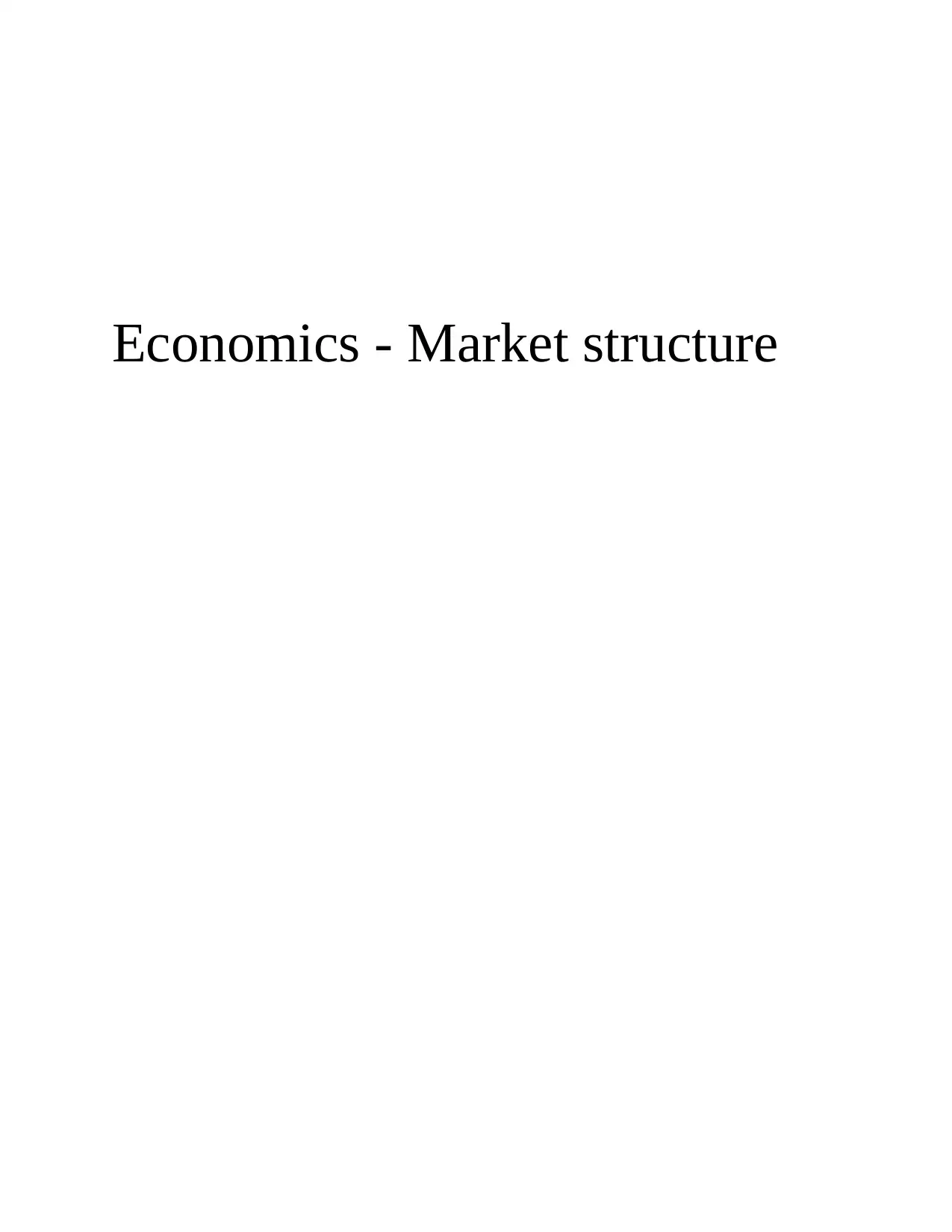
Economics - Market structure
Paraphrase This Document
Need a fresh take? Get an instant paraphrase of this document with our AI Paraphraser
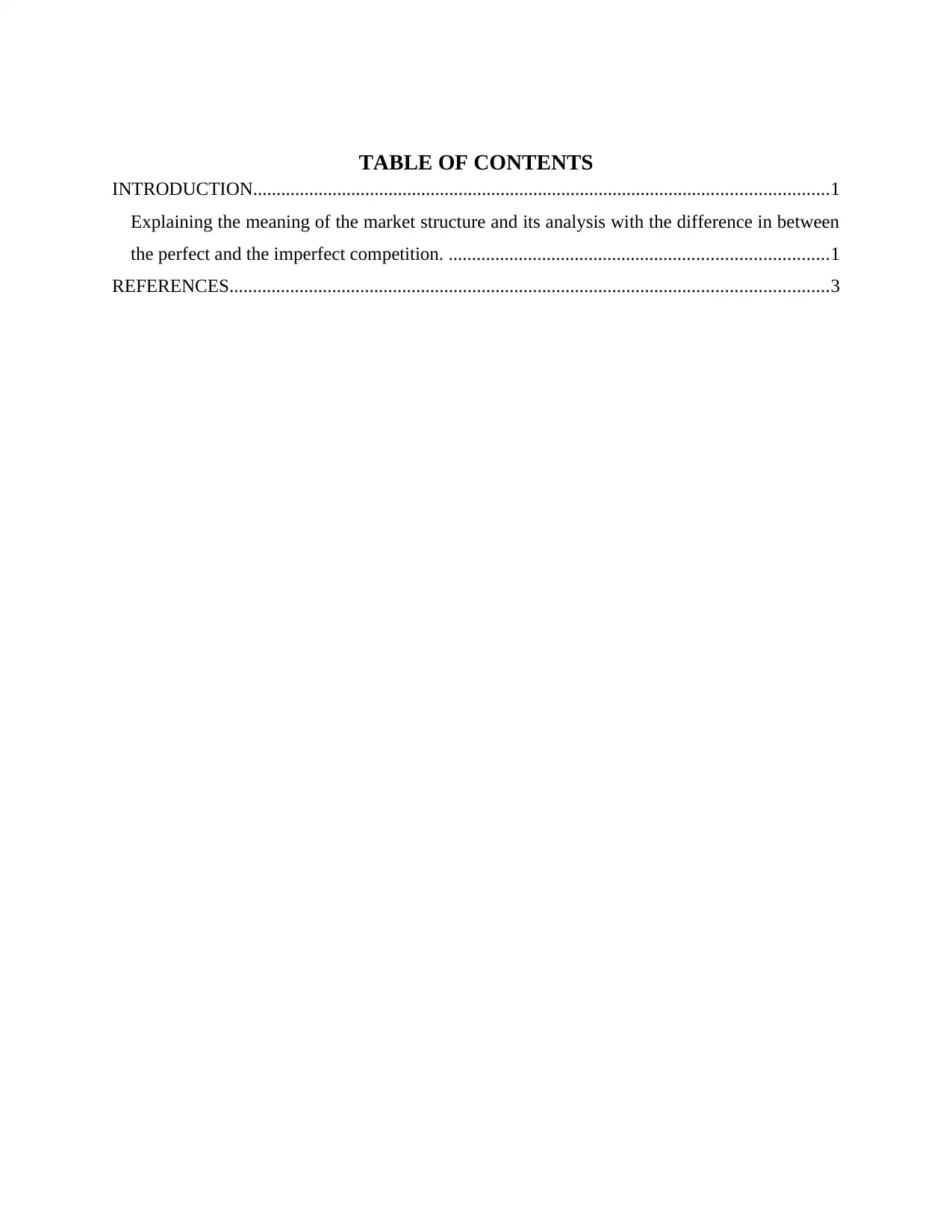
TABLE OF CONTENTS
INTRODUCTION...........................................................................................................................1
Explaining the meaning of the market structure and its analysis with the difference in between
the perfect and the imperfect competition. .................................................................................1
REFERENCES................................................................................................................................3
INTRODUCTION...........................................................................................................................1
Explaining the meaning of the market structure and its analysis with the difference in between
the perfect and the imperfect competition. .................................................................................1
REFERENCES................................................................................................................................3
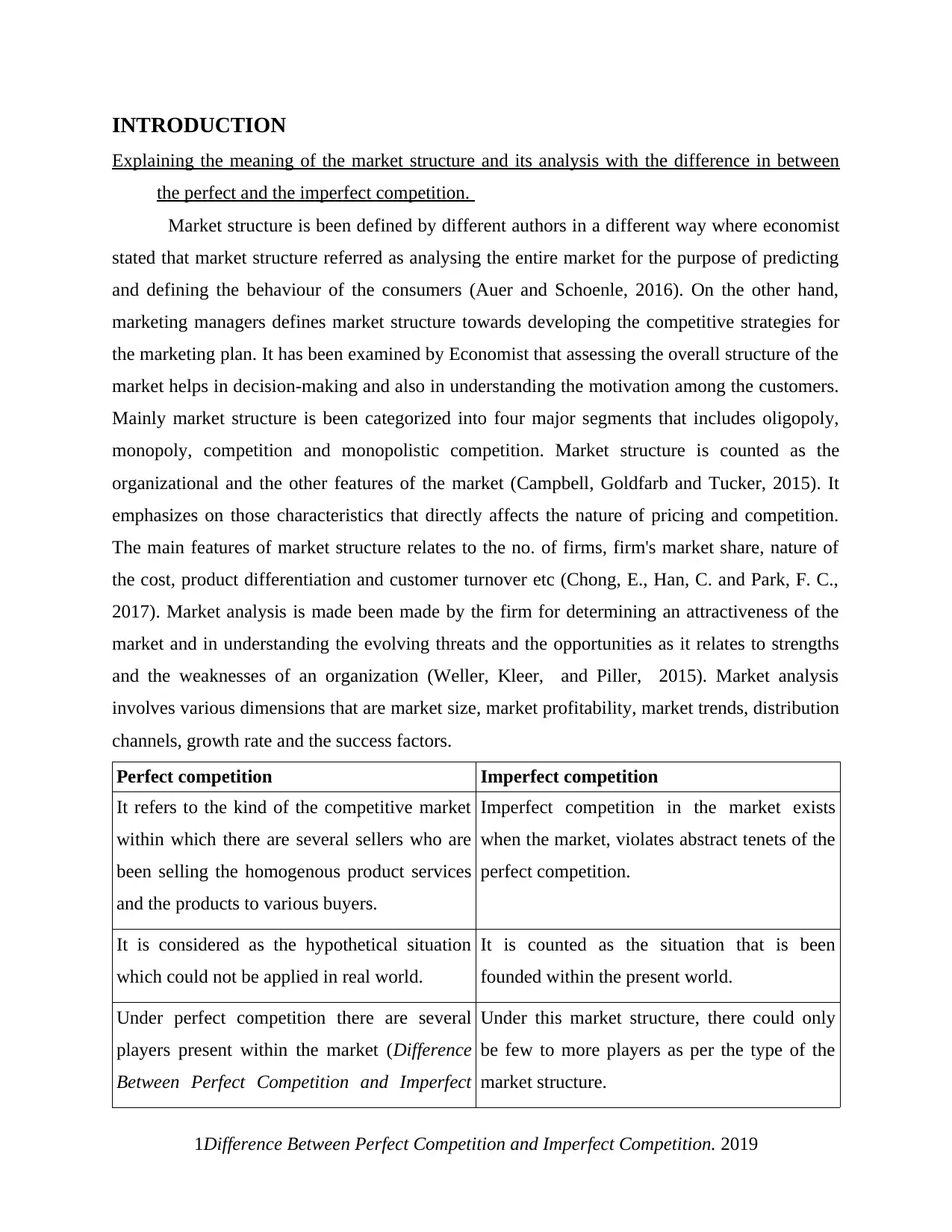
INTRODUCTION
Explaining the meaning of the market structure and its analysis with the difference in between
the perfect and the imperfect competition.
Market structure is been defined by different authors in a different way where economist
stated that market structure referred as analysing the entire market for the purpose of predicting
and defining the behaviour of the consumers (Auer and Schoenle, 2016). On the other hand,
marketing managers defines market structure towards developing the competitive strategies for
the marketing plan. It has been examined by Economist that assessing the overall structure of the
market helps in decision-making and also in understanding the motivation among the customers.
Mainly market structure is been categorized into four major segments that includes oligopoly,
monopoly, competition and monopolistic competition. Market structure is counted as the
organizational and the other features of the market (Campbell, Goldfarb and Tucker, 2015). It
emphasizes on those characteristics that directly affects the nature of pricing and competition.
The main features of market structure relates to the no. of firms, firm's market share, nature of
the cost, product differentiation and customer turnover etc (Chong, E., Han, C. and Park, F. C.,
2017). Market analysis is made been made by the firm for determining an attractiveness of the
market and in understanding the evolving threats and the opportunities as it relates to strengths
and the weaknesses of an organization (Weller, Kleer, and Piller, 2015). Market analysis
involves various dimensions that are market size, market profitability, market trends, distribution
channels, growth rate and the success factors.
Perfect competition Imperfect competition
It refers to the kind of the competitive market
within which there are several sellers who are
been selling the homogenous product services
and the products to various buyers.
Imperfect competition in the market exists
when the market, violates abstract tenets of the
perfect competition.
It is considered as the hypothetical situation
which could not be applied in real world.
It is counted as the situation that is been
founded within the present world.
Under perfect competition there are several
players present within the market (Difference
Between Perfect Competition and Imperfect
Under this market structure, there could only
be few to more players as per the type of the
market structure.
1Difference Between Perfect Competition and Imperfect Competition. 2019
Explaining the meaning of the market structure and its analysis with the difference in between
the perfect and the imperfect competition.
Market structure is been defined by different authors in a different way where economist
stated that market structure referred as analysing the entire market for the purpose of predicting
and defining the behaviour of the consumers (Auer and Schoenle, 2016). On the other hand,
marketing managers defines market structure towards developing the competitive strategies for
the marketing plan. It has been examined by Economist that assessing the overall structure of the
market helps in decision-making and also in understanding the motivation among the customers.
Mainly market structure is been categorized into four major segments that includes oligopoly,
monopoly, competition and monopolistic competition. Market structure is counted as the
organizational and the other features of the market (Campbell, Goldfarb and Tucker, 2015). It
emphasizes on those characteristics that directly affects the nature of pricing and competition.
The main features of market structure relates to the no. of firms, firm's market share, nature of
the cost, product differentiation and customer turnover etc (Chong, E., Han, C. and Park, F. C.,
2017). Market analysis is made been made by the firm for determining an attractiveness of the
market and in understanding the evolving threats and the opportunities as it relates to strengths
and the weaknesses of an organization (Weller, Kleer, and Piller, 2015). Market analysis
involves various dimensions that are market size, market profitability, market trends, distribution
channels, growth rate and the success factors.
Perfect competition Imperfect competition
It refers to the kind of the competitive market
within which there are several sellers who are
been selling the homogenous product services
and the products to various buyers.
Imperfect competition in the market exists
when the market, violates abstract tenets of the
perfect competition.
It is considered as the hypothetical situation
which could not be applied in real world.
It is counted as the situation that is been
founded within the present world.
Under perfect competition there are several
players present within the market (Difference
Between Perfect Competition and Imperfect
Under this market structure, there could only
be few to more players as per the type of the
market structure.
1Difference Between Perfect Competition and Imperfect Competition. 2019
⊘ This is a preview!⊘
Do you want full access?
Subscribe today to unlock all pages.

Trusted by 1+ million students worldwide
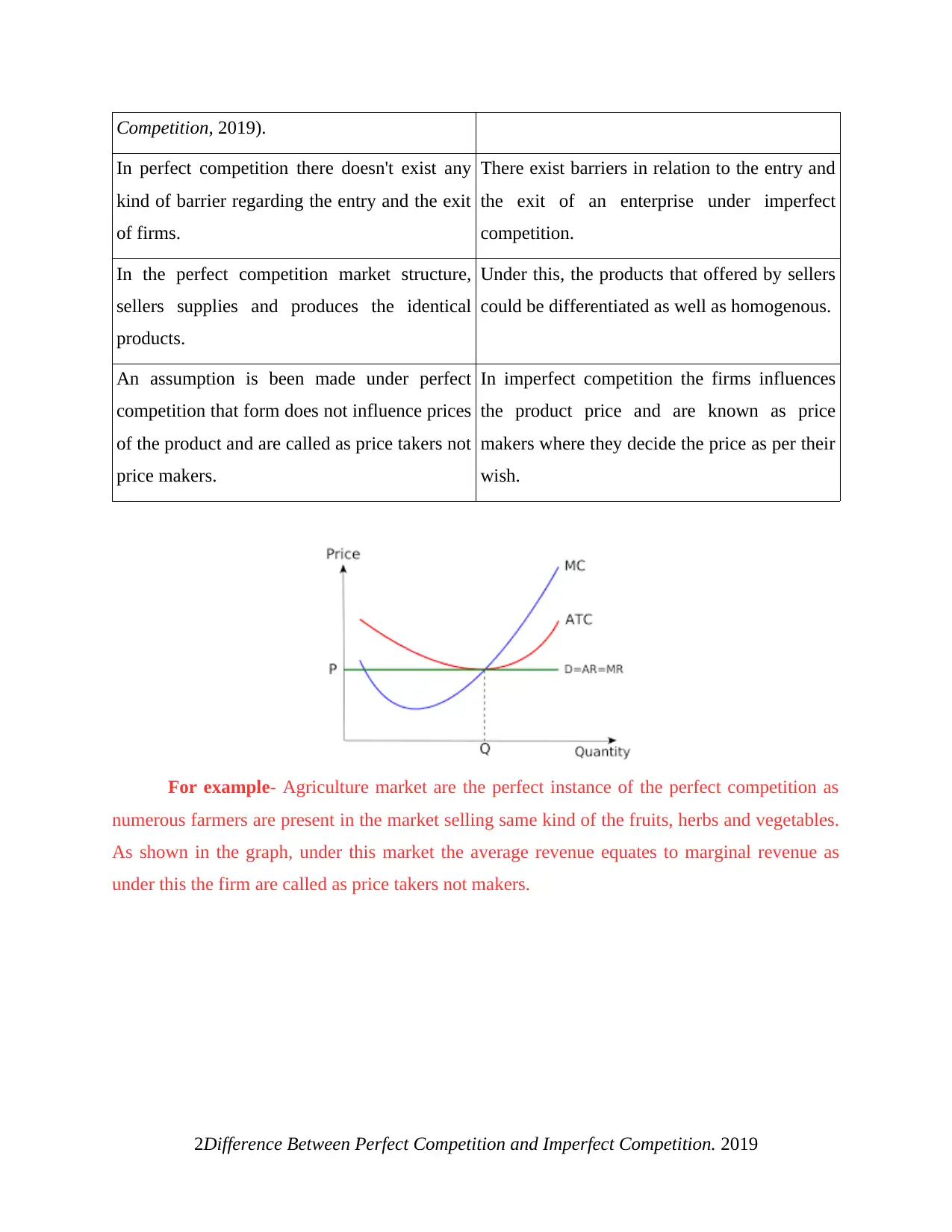
Competition, 2019).
In perfect competition there doesn't exist any
kind of barrier regarding the entry and the exit
of firms.
There exist barriers in relation to the entry and
the exit of an enterprise under imperfect
competition.
In the perfect competition market structure,
sellers supplies and produces the identical
products.
Under this, the products that offered by sellers
could be differentiated as well as homogenous.
An assumption is been made under perfect
competition that form does not influence prices
of the product and are called as price takers not
price makers.
In imperfect competition the firms influences
the product price and are known as price
makers where they decide the price as per their
wish.
For example- Agriculture market are the perfect instance of the perfect competition as
numerous farmers are present in the market selling same kind of the fruits, herbs and vegetables.
As shown in the graph, under this market the average revenue equates to marginal revenue as
under this the firm are called as price takers not makers.
2Difference Between Perfect Competition and Imperfect Competition. 2019
In perfect competition there doesn't exist any
kind of barrier regarding the entry and the exit
of firms.
There exist barriers in relation to the entry and
the exit of an enterprise under imperfect
competition.
In the perfect competition market structure,
sellers supplies and produces the identical
products.
Under this, the products that offered by sellers
could be differentiated as well as homogenous.
An assumption is been made under perfect
competition that form does not influence prices
of the product and are called as price takers not
price makers.
In imperfect competition the firms influences
the product price and are known as price
makers where they decide the price as per their
wish.
For example- Agriculture market are the perfect instance of the perfect competition as
numerous farmers are present in the market selling same kind of the fruits, herbs and vegetables.
As shown in the graph, under this market the average revenue equates to marginal revenue as
under this the firm are called as price takers not makers.
2Difference Between Perfect Competition and Imperfect Competition. 2019
Paraphrase This Document
Need a fresh take? Get an instant paraphrase of this document with our AI Paraphraser
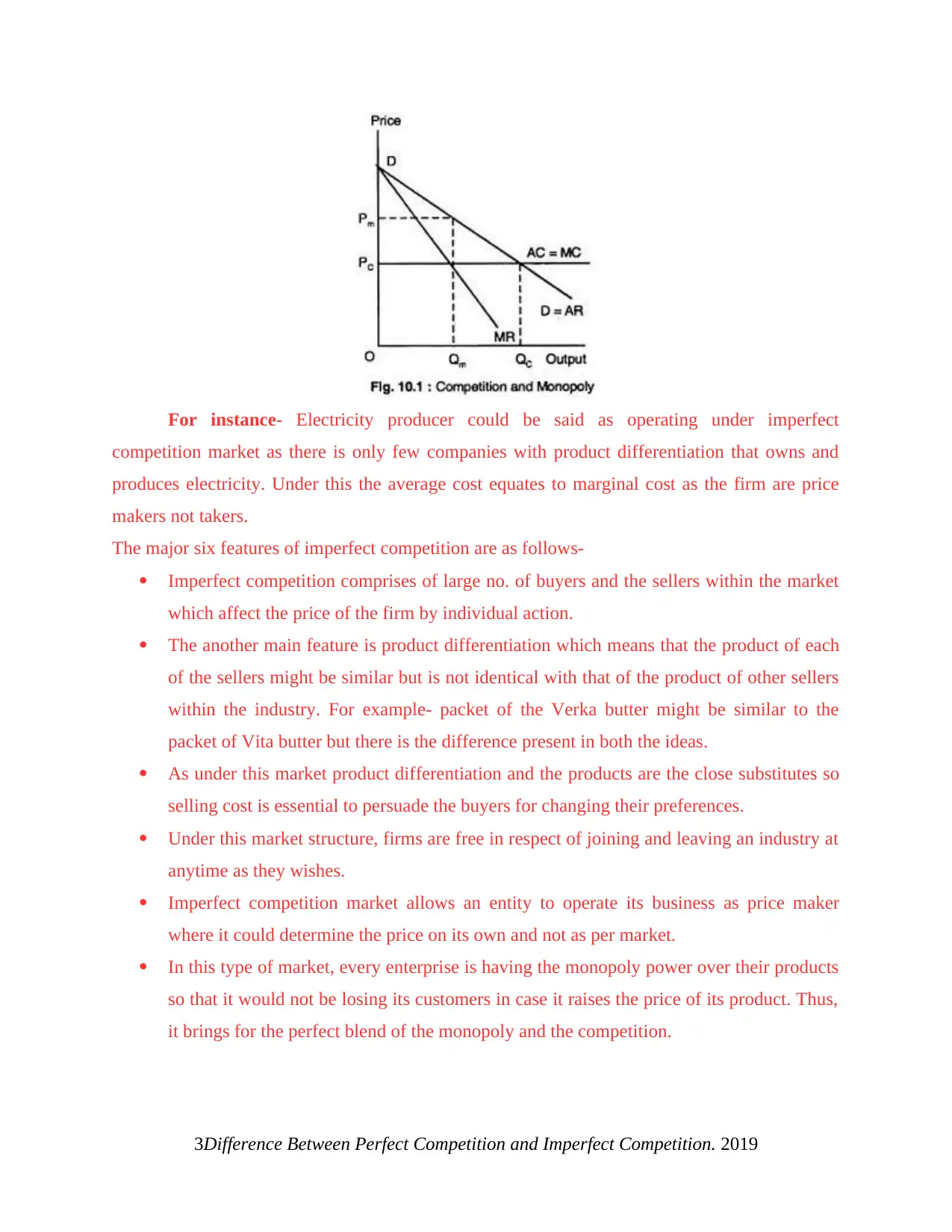
For instance- Electricity producer could be said as operating under imperfect
competition market as there is only few companies with product differentiation that owns and
produces electricity. Under this the average cost equates to marginal cost as the firm are price
makers not takers.
The major six features of imperfect competition are as follows-
Imperfect competition comprises of large no. of buyers and the sellers within the market
which affect the price of the firm by individual action.
The another main feature is product differentiation which means that the product of each
of the sellers might be similar but is not identical with that of the product of other sellers
within the industry. For example- packet of the Verka butter might be similar to the
packet of Vita butter but there is the difference present in both the ideas.
As under this market product differentiation and the products are the close substitutes so
selling cost is essential to persuade the buyers for changing their preferences.
Under this market structure, firms are free in respect of joining and leaving an industry at
anytime as they wishes.
Imperfect competition market allows an entity to operate its business as price maker
where it could determine the price on its own and not as per market.
In this type of market, every enterprise is having the monopoly power over their products
so that it would not be losing its customers in case it raises the price of its product. Thus,
it brings for the perfect blend of the monopoly and the competition.
3Difference Between Perfect Competition and Imperfect Competition. 2019
competition market as there is only few companies with product differentiation that owns and
produces electricity. Under this the average cost equates to marginal cost as the firm are price
makers not takers.
The major six features of imperfect competition are as follows-
Imperfect competition comprises of large no. of buyers and the sellers within the market
which affect the price of the firm by individual action.
The another main feature is product differentiation which means that the product of each
of the sellers might be similar but is not identical with that of the product of other sellers
within the industry. For example- packet of the Verka butter might be similar to the
packet of Vita butter but there is the difference present in both the ideas.
As under this market product differentiation and the products are the close substitutes so
selling cost is essential to persuade the buyers for changing their preferences.
Under this market structure, firms are free in respect of joining and leaving an industry at
anytime as they wishes.
Imperfect competition market allows an entity to operate its business as price maker
where it could determine the price on its own and not as per market.
In this type of market, every enterprise is having the monopoly power over their products
so that it would not be losing its customers in case it raises the price of its product. Thus,
it brings for the perfect blend of the monopoly and the competition.
3Difference Between Perfect Competition and Imperfect Competition. 2019
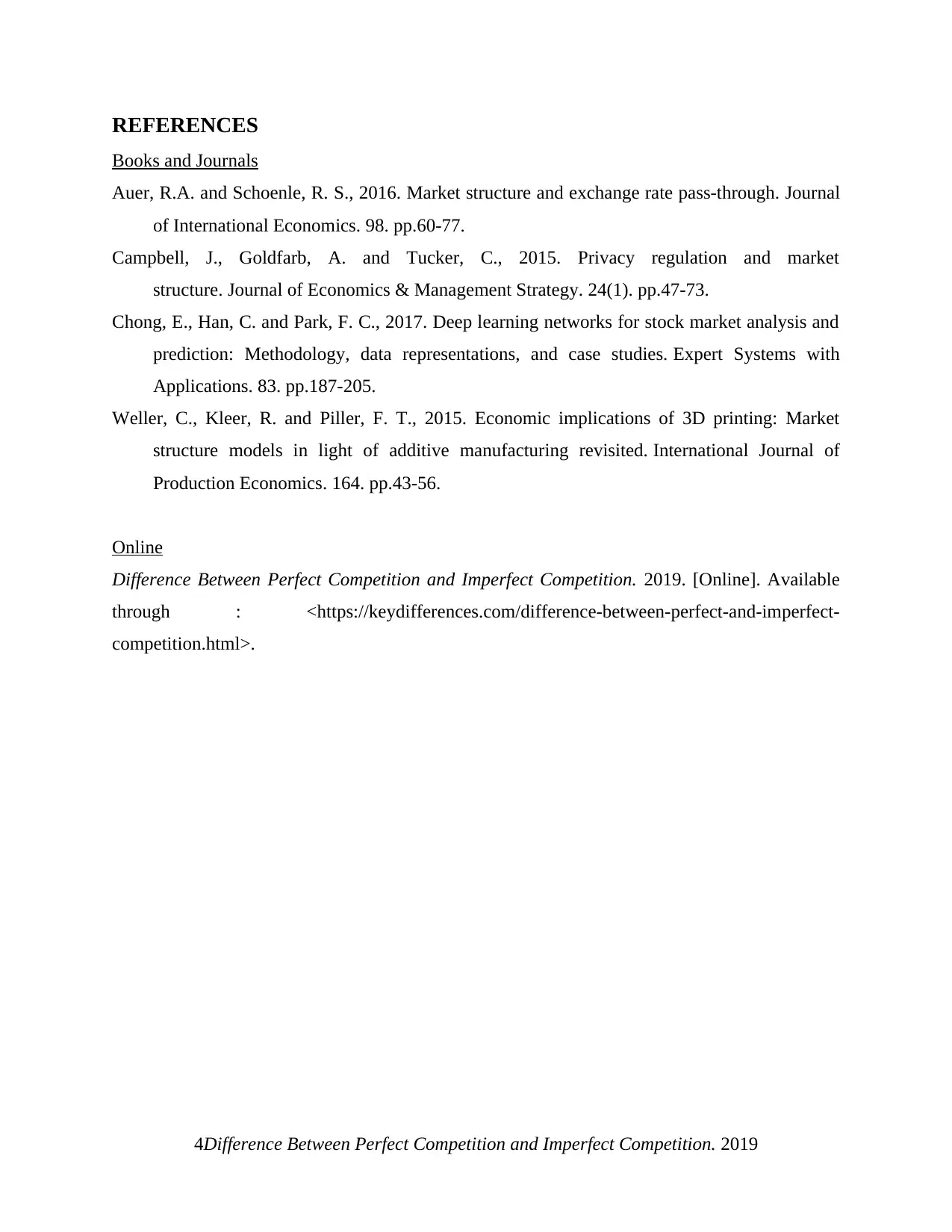
REFERENCES
Books and Journals
Auer, R.A. and Schoenle, R. S., 2016. Market structure and exchange rate pass-through. Journal
of International Economics. 98. pp.60-77.
Campbell, J., Goldfarb, A. and Tucker, C., 2015. Privacy regulation and market
structure. Journal of Economics & Management Strategy. 24(1). pp.47-73.
Chong, E., Han, C. and Park, F. C., 2017. Deep learning networks for stock market analysis and
prediction: Methodology, data representations, and case studies. Expert Systems with
Applications. 83. pp.187-205.
Weller, C., Kleer, R. and Piller, F. T., 2015. Economic implications of 3D printing: Market
structure models in light of additive manufacturing revisited. International Journal of
Production Economics. 164. pp.43-56.
Online
Difference Between Perfect Competition and Imperfect Competition. 2019. [Online]. Available
through : <https://keydifferences.com/difference-between-perfect-and-imperfect-
competition.html>.
4Difference Between Perfect Competition and Imperfect Competition. 2019
Books and Journals
Auer, R.A. and Schoenle, R. S., 2016. Market structure and exchange rate pass-through. Journal
of International Economics. 98. pp.60-77.
Campbell, J., Goldfarb, A. and Tucker, C., 2015. Privacy regulation and market
structure. Journal of Economics & Management Strategy. 24(1). pp.47-73.
Chong, E., Han, C. and Park, F. C., 2017. Deep learning networks for stock market analysis and
prediction: Methodology, data representations, and case studies. Expert Systems with
Applications. 83. pp.187-205.
Weller, C., Kleer, R. and Piller, F. T., 2015. Economic implications of 3D printing: Market
structure models in light of additive manufacturing revisited. International Journal of
Production Economics. 164. pp.43-56.
Online
Difference Between Perfect Competition and Imperfect Competition. 2019. [Online]. Available
through : <https://keydifferences.com/difference-between-perfect-and-imperfect-
competition.html>.
4Difference Between Perfect Competition and Imperfect Competition. 2019
⊘ This is a preview!⊘
Do you want full access?
Subscribe today to unlock all pages.

Trusted by 1+ million students worldwide
1 out of 6
Related Documents
Your All-in-One AI-Powered Toolkit for Academic Success.
+13062052269
info@desklib.com
Available 24*7 on WhatsApp / Email
![[object Object]](/_next/static/media/star-bottom.7253800d.svg)
Unlock your academic potential
Copyright © 2020–2025 A2Z Services. All Rights Reserved. Developed and managed by ZUCOL.





